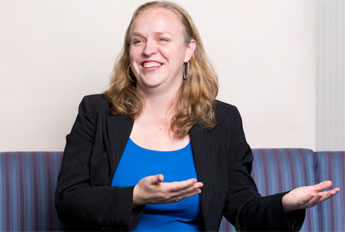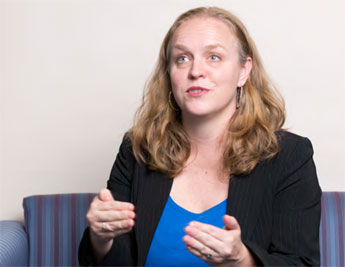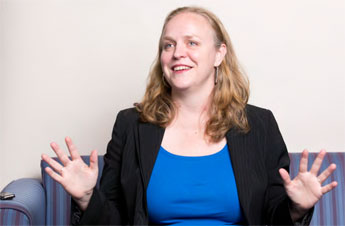
Scene: Large corner office, 10th (and top) floor of an old downtown Newark office building. Nice navy-blue sofa, very large desk, executive-style conference table, framed pictures and posters on the walls, floor-to-ceiling windows on two corners, and doors that open onto a rooftop deck.
“This is a super office,” I exclaim, asking Cami Anderson, the new superintendent of Newark schools, to tell me a little bit about it.
Sitting a bit stiffly on the sofa, Anderson winces. “I hate it. My ideal would be to take one of our old, gorgeous schools and make it a place of bustling collaboration and activity between adults and children,” she says. “That would actually look and feel quite different than our corporate tower here.”
This California blond is clearly not your ordinary educator, which could be the best thing that has happened to the perennially failing Newark Public Schools (NPS) since—well, perhaps, ever. The state took over the district in 1995, to little effect. With 75 schools and almost 40,000 students, Newark is the largest district in New Jersey, and with graduation rates hovering just about 50 percent, one of the most troubled. Enrollment is down some 9,000 students since 2001. As the New York Times reported when Anderson took over, in June of 2011, “Cami Anderson faces the monumental task of rescuing an urban school system that has long been mired in low achievement, high turnover and a culture of failure, despite decades of state intervention.”
It was, said the Times, with exquisite understatement, “the ultimate high-risk opportunity.”
Even with the popular and smart Newark mayor Cory Booker on her side and a $100 million gift from Facebook founder Mark Zuckerberg, she’ll need all the help she can get. As even Chris Christie, the take-no-prisoners Garden State governor, said at the press conference announcing Anderson’s appointment, “It took us a long time to get to where we are now [in Newark], and no leader, no matter how good, is going to be able to turn this around overnight.”
It would have been hard to find anyone disagreeing with the blunt-spoken governor on that one.
“Judge me by my actions,” Anderson said at the time. “Let me roll up my sleeves and dive in. Then we’ll talk.”
And talk we did, last May, just as Anderson was finishing her first year on the job. “The first year of anything is tough because you’re saying, ‘Trust me. Trust me. Trust me,’” she said. “But you haven’t really had time to,
‘Show me. Show me. Show me.’”
Shaking Things Up
In fact, Anderson showed her stuff immediately.
“I had to make some very important leadership decisions,” she recalled about those first days on the job, “right then.” And since Anderson’s “theory of change” is about “great school leaders,” she “ran around to as many schools as possible to try to get a sense of the quality of our principals, most particularly those who I’d heard deep concerns about or had heard were awesome and were approaching their tenure date.”
The result? Seventeen new principals when school opened the following September. Major shakeup. Indeed, Anderson’s first year in Newark was marked by serious change—she closed six schools, reorganized her central administration team, cut 120 jobs—and marked the beginning of a deep systemic overhaul, financial and pedagogical.
So far, so good. There have been the fights over the school closings and the upset of a system being (rather quickly) turned inside out, but as friends predicted, Anderson’s engaging personal style won many people over. She did not arrive with an agenda, but she did have a clear vision of where to start—even before the principal shakeup.
“The first thing is to define success,” she said. “And that’s pretty simple. Every kid of school age in Newark is in a school that puts him or her on the path to graduate from college.”
That is, as Anderson recognizes, “a very lofty aspirational goal, considering that we have about a third of our kids reading at grade level by the 3rd grade, and that we graduate about 55 percent of our kids, and only 23 percent of those do so by passing high-stakes tests. And of those who graduate, 90 percent need remediation, which ultimately is a sure ticket to dropping out and having debt, right?”
Anderson is no pie-in-the sky reformer. “You have to be honest about the gap between where you are and your goal,” she said. And she and her new crew, which included Photeine Anagnostopoulos, a savvy former Morgan Stanley financial analyst who worked with Anderson in Joel Klein’s shop in New York City, have spent “a fair amount of time defining where we are.” It wasn’t a good spot.
They hired Educational Resource Strategies (ERS) to study the distribution of dollars across students in the district and discovered that “it was the most inequitably distributed set of dollars across schools they had ever seen, by far,” said Anagnostopoulos, who also found that 25 percent of the district’s costs were in building and maintenance. “It should be closer to 10 percent,” she said. Anderson wanted “a real and clear picture” of the health of the district, financially and academically. And she got it.
The Race Card
 Many believed that Anderson would be waylaid by Newark’s famously polarizing racial politics.
Many believed that Anderson would be waylaid by Newark’s famously polarizing racial politics.
“I don’t know if you’ve noticed,” I told Anderson, “but you are white. And this is Newark.”
“That may be the funniest thing I’ve ever heard,” roared Anderson. “My entire life I have grown up in and participated in all kinds of cross-cultural conversations…. We’re going to have some tough conversations. But it’s something that I think is really important.”
Anderson’s partner is a black man (“a recovering corporate banker turned improv artist turned entrepreneur,” said Anderson), and they have a young son together. They moved to downtown Newark shortly after her appointment. Anderson herself grew up in a large, interracial family (more on that below).
And there’s Cory Booker, black mayor of Newark—and friend. When Booker decided to run for the top job in year 2002, Anderson was there. In fact, she took a leave of absence from her job as executive director of Teach For America-New York (TFA-NY) to serve as Booker’s director of policy and strategy. “Though school reform is my primary passion,” she said, “I have, throughout my life, become involved in campaigns where I felt like there was a game-changing candidate.” It would appear that Booker has been that (see “Home Is Where the Heart Is,” features, Fall 2006). And the added benefit of working on his campaign, said Anderson, was getting to know Newark.
“I made lots of friends during that campaign.”
The Perfect Reform Leader
 Cami Anderson may just be the perfect choice for leading Newark Public Schools to a postracial promised land.
Cami Anderson may just be the perfect choice for leading Newark Public Schools to a postracial promised land.
She has degrees from the University of California at Berkeley (BA in education and anthropology) and Harvard (MA in public policy and education). She has been a classroom teacher, in theater arts and in a Montessori school. She was chief program officer for New Leaders for New Schools (2002‒05), overseeing the training of new, reform-minded principals. While she was there, the organization was recognized as one of the most successful nonprofits in America by Fast Company magazine and Harvard Business School. At TFA-NY (1997‒2002), she increased funding by 300 percent, overseeing the training and performance of over 500 teachers in more than 90 schools.
When Christie tapped her to run Newark’s schools, she was one of a handful of education reformers in the country who had made the transition from the entrepreneurial side of the business to managing full-bodied traditional systems in transition. She had just completed a four-year stint as one of Joel Klein’s top lieutenants, as senior superintendent in charge of alternative high schools and programs, which served 30,000 students under 21 and 60,000 students in correctional facilities, suspension centers, and drug treatment centers in addition to students seeking a GED, career/technical education, and teen pregnancy services.
While it is tempting to trace Anderson’s operations and systems management expertise to Harvard and her public policy and education degree, the true source of her proficiencies in those areas can probably be attributed to growing up in a family of 12 children. “I don’t even remember the sequencing of all of us,” she laughed. “But basically, from the time I was 3 until the time I was 12, there was someone who came to our family through adoption just about every year. And at the very end, my mother had my youngest blood brother. So there were two blood siblings, nine adopted, and then Brock came at the very end.”
This kind of family might also explain why, when I asked Anderson who her education heroes are, she said, without hesitation, “My mom.” Her mother was not a traditional educator, but “she has an uncanny ability to zero in on the feedback that you get even from your greatest enemy. Her basic philosophy in life—she calls it the One Percent Rule—is that in every situation you personally have an impact on the outcome, whether it’s 1 percent or 100 percent.”
Her parents came from working-class families in the Bay Area of California and became “activist types” in the 1960s. They moved to L.A., where her father enrolled at the University of Southern California, then worked at the Watts Labor Action Community Committee, then for Mayor Tom Bradley.
“For many years, mom was working in parent training, family support work, and through that had done a lot with young people who were being transitioned into foster homes or into adoptive families,” Anderson explained.
“And there were lots of cases where kids were deemed hard-to-place, for a host of reasons that we all find horrible, either because of physical handicap or age.” Anderson’s mom brought many of them home, nine permanently.
She describes it as “a do-it-yourself household. We all had kitchen night, laundry night, daily jobs, weekly jobs, work wheels, coupons. This is why I’m a systems person.”
Mission Driven
 And that is how Anderson is making over Newark Public Schools. She says she has never been a long-range planner. She is more mission-driven than career-oriented. She fell into teaching and “only worked with kids who had been suspended or kicked out of their classroom.” She was always creating “a strong culture, creating rituals, creating shared responsibility,” as her mom had taught her. “My principal would say, ‘This is brilliant.’ And I thought, ‘Well, yeah, this is pretty much my house on a Sunday.’”
And that is how Anderson is making over Newark Public Schools. She says she has never been a long-range planner. She is more mission-driven than career-oriented. She fell into teaching and “only worked with kids who had been suspended or kicked out of their classroom.” She was always creating “a strong culture, creating rituals, creating shared responsibility,” as her mom had taught her. “My principal would say, ‘This is brilliant.’ And I thought, ‘Well, yeah, this is pretty much my house on a Sunday.’”
Anderson believes that education is a way of leveling the playing field. “I never thought, ‘One day I’m going to be a lifelong educator,’” she said. “I thought, ‘One day I’m going to be part of a generation of people that fundamentally changes the relationship between poverty and race and the American dream.’”
If it’s not yet an entire generation, Anderson sure has the qualities to lead others to the dream.
Peter Meyer, former news editor at Life Magazine, is senior policy fellow with the Thomas B. Fordham Institute and contributing editor at Education Next.
This article appeared in the Winter 2013 issue of Education Next. Suggested citation format:
Meyer, P. (2013). Newark’s Superintendent Rolls Up Her Sleeves and Gets to Work: A conversation with Cami Anderson. Education Next, 13(1), 50-53.


